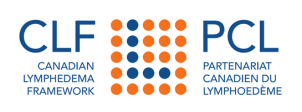Pathways is a quarterly full-colour magazine published by the Canadian Lymphedema Framework. Canadian subscriptions can be obtained through the various provincial associations, as a benefit of their annual membership fees.
USA and International as well as Canadian print and digital subscriptions can be ordered directly through the CLF at this link.
If you would like a downloadable copy of these articles for use in your clinics, or to distribute to patients, please contact pathways@canadalymph.ca. More recent articles and back issues are available for purchase by contacting the Canadian Lymphedema Framework at pathways@canadalymph.ca
Psychological aspects of living with a chronic disease like lymphedema
by Gabriele Erbacher
Theoretical background and practical examples. (Fall 2022)
Lymphedema is a lifelong risk
Interview by Anna Kennedy and Dr. Anna Towers
An interview with Dr. Wei Chen of the Cleveland Clinic. (Summer 2021)
Why is lymphedema so hard to diagnose?
by Savannah Paetzel and Melissa Aldrich
Let’s talk about lymphedema imaging technologies. (Winter 2020)
Anatomy and physiology of the lymphatic system
by Kathleen Francis
Knowledge, understanding and commitment are the keys to long-term success. (Fall 2020)
The complexity of garment fitting: Does your garment fit well?
by Katrin Schumann and Marie-Eve Letellier
Whether you are new to lymphedema management or quite experiences, this article will educate you about your prescription, your fitter and your garment. (Summer 2018)
Living Well With Lymphedema: Skin Care Secrets
by Robyn A. Smith
Based on clinical experience. Article based on a presentation given at the National Lymphedema Network 2017 annual conference Patient Summit held Oct 18-22 (Spring 2018)
Standard Treatment of Care Explained
by Guenter Klose
Complete Decongestive Therapy (CDT) remains the standard of care for patients living with lymphedema, despite the increased number of surgeries performed on patients with lymphedema. (Fall 2018)
Precautionary Practices for Lymphedema
by Maria Asdourian et. al.
Current lymphedema risk reduction and education strategies for breast cancer survivors should be reconsidered (Summer 2016)
Symptom Reporting as a Useful Tool to Detect Lymphedema
by Dr. Mei R. Fu
Self-reporting provides preliminary understanding of lymphedema symptoms (Spring 2016)
Surgery for Lymphedema Treatment
by Dr. Jay Granzow
Modern procedures have found greater precision in treating lymphedema (Winter 2016)
Making the Case for Safe and Effective Resistance Exercise
by Kristin Campbell
Translating research into practice for individuals with breast-cancer related lymphedema (Fall 2015)
Technologies Improve Accuracy and Reliability
by Margie McNeely
Lymphedema measurement technologies improve (Summer 2015)
Top-Ten Self Care Tips
by Lori Radke
Help keep your limb healthy and your lymphedema under control (Summer 2015)
Pneumatic Compression Pumps
by Karen Ashforth
Pneumatic Compression is experiencing a resurgence in popularity and is an effective tool for achieving decongestion in both the acute and maintenance phases of lymphedema treatment (Spring 2015)
Surgical Treatment Options for Lymphedema
by Dalia Tobbia
Current trends in the surgical treatment for lymphedema and the realistic outcomes that can be expected from each procedure (Spring 2015)
Nutritional Considerations in Lymphedema
by Hillary Sachs
Nutrition and health typically go hand in hand. Maintaining good health and diet can positively impact lymphedema (Winter 2015)
To Pump or Not to Pump
by Guenter Klose
When used in conjunction with other, daily self-care measures, a pump may lead to further limb volume reduction, improved range of motion, a decrease in subjective complaints such as heaviness and achiness, and, ultimately, an improved quality of life. (Winter 2014)
Managing the Psychosocial Aspects of Lymphedema
by Jane Durston
Successful management of lymphedema starts with effective self-care. This research suggests that subtle changes in the behaviour and lifestyle of patients could revolutionize one’s perspective on living with lymphedema. (Fall 2014)
Lower Limb Lymphedema after Gynecological Cancer Surgery
by Mei Fu, Kun Li & Jeanna Qu
Patients undergoing gynecological cancer treatment need to be educated on the risk factors of lymphedema and self-monitoring to ensure early detection and timely treatment (Summer 2014)
Understanding Cellulitis: A serious concern for lymphedema patients and those at risk
by Dr. Mieke Flour
A dermatologist offers us an in-depth understanding of cellulitis, offering strategies to alleviate symptoms (Spring 2014)
Exercise For and With Lymphedema: Proceed with caution – but proceed
by Dorit Tidhar & DeCourcy Squire
Experts discuss the role of exercise in the treatment for lymphedema and about guidelines for a safe return to more vigorous activity – exercise with lymphedema (Winter 2014)
Reading Research Critically: Top 10 Questions to Ask
by Roanne Thomas
Ten questions to help guide your evaluation of research (Summer 2013)
Improving Your Quality of Life: How to maintain a positive mentality
by Elizabeth McMahon
Emotional self-care helps you protect your quality of life from lymphedema and increase your happiness. (Summer 2013)
Getting More Physically Active: Good reasons to exercise
by Margie McNeely
A practical step-by-step process to start a safe and effective exercise regime. (Spring 2013)
The Contemporary Surgical Treatment of Lymphedema: A popular topic for discussion
by Janice Cormier & Kate Cromwell
Surgical interventions offer some promise for patients unresponsive to traditional treatments, however further research is required (Winter 2013)
Donning Aids for Compression: Making adherence to treatment easier
by Leda Raptis
Patients have many options for aids to help put on and remove compression garments, including sewing their own slider! (Fall 2012)
Compression Garments: A fitter’s perspective on consumer choice
by Jean Ann Ryan
There are a myriad of compression garments on the market and trusting your fitter is the first step in making informed choices (Fall 2012)
Early Shoulder Exercises for Reducing Complications After Breast Cancer Treatment
by Dorit Tidhar
Lack of movement of the shoulder after breast cancer surgery can lead to reduced function, yet, too much movement too early can increase the risk for lymphedema. (Spring 2012)
We acknowledge the support of the Government of Canada.

